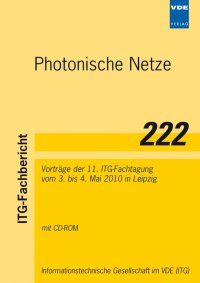Quantitative Analysis of Network Architectures for Future National Optic Transport Networks (OTN)
Conference: Photonische Netze - 11. ITG-Fachtagung
05/03/2010 - 05/04/2010 at Leipzig, Germany
Proceedings: Photonische Netze
Pages: 7Language: englishTyp: PDF
Personal VDE Members are entitled to a 10% discount on this title
Authors:
Engel, Thomas; Autenrieth, Achim; Voll, Stefan (Nokia Siemens Networks, 80240 München)
Abstract:
The constant cost pressure and growing traffic volumes are pushing network operators to increase the efficiency of access, aggregation and core networks. The key target is reduced cost per transported bit. New developments in the standardization of OTN G.709, specifically the introduction of ODU0, allow an efficient aggregation and grooming of 1GbE and higher data services. A key element for this network function is an OTN node, which combines an electrical ODU switching on the ODU layer with an optical switching in the DWDM transport layer. In a multi-domain network the OTN node additionally acts as a demarcation point between optical transparency domains. In this paper several network architectures for future national optical transport networks are defined based on the requirements of network operators on the functionality of an optical transport network and of an OTN node. The base reference network model is a simple network architecture with a single domain, either with or without ODU switching functionality. However, the focus of this paper is on more realistic network architectures with multiple optical transparency domains – first a hierarchical multi-domain network with a dedicated core network and secondly a flat multidomain network with peering domains and inter-domain traffic exchange points. Both architectures fully support multivendor capability and resilience requirements. After the description of the proposed network architectures, this paper presents a quantitative network evaluation and cost analysis based on a realistic German reference network with aggregated traffic streams of business and residential services. In addition to the cost evaluation, the network architectures are evaluated based on the size distribution of the ODU switch fabric, as well as the wavelength utilization of the DWDM transmission system. The results show that an OTN node increases the flexibility and scalability of optical transport networks. This flexibility requires an initial investment in the transport network equipment, which is balanced with reduced operational cost and a better utilization of the fibre systems, which leads to an increased network lifetime.


